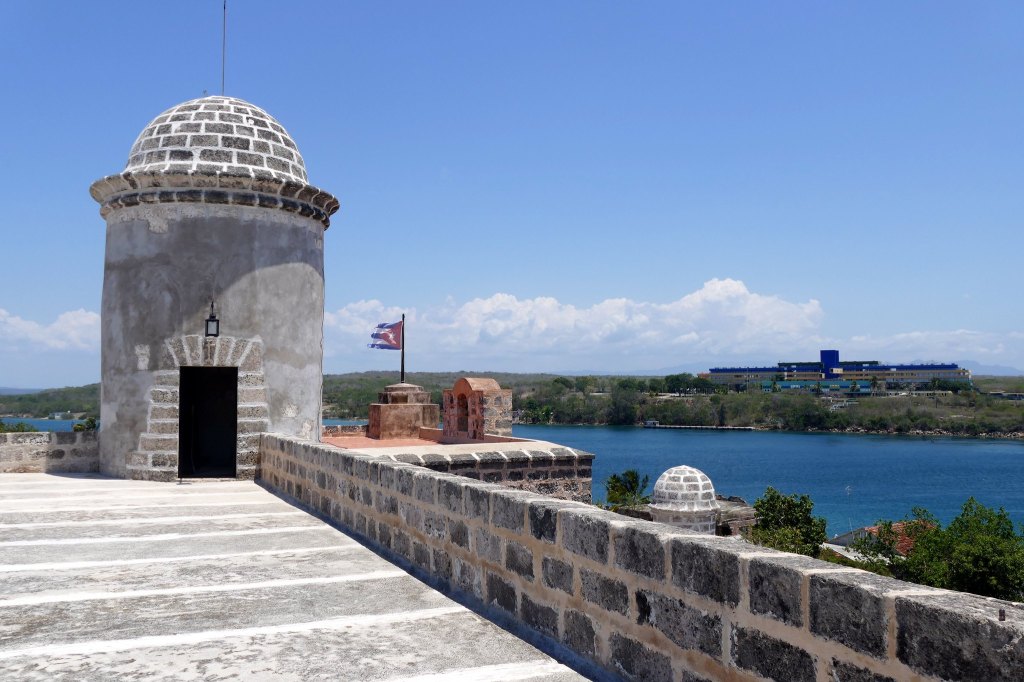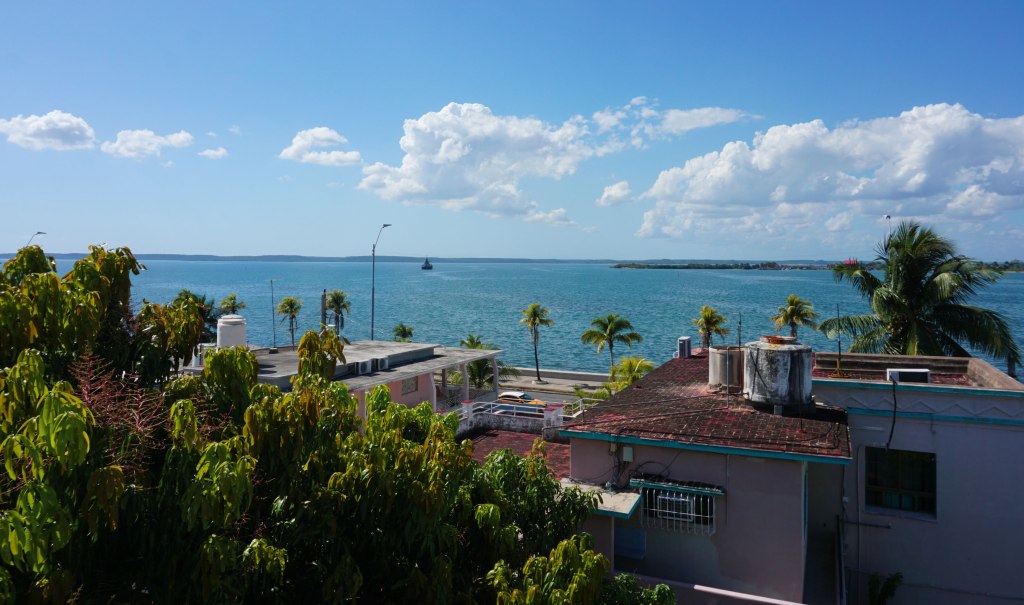
Nestled in the south eastern coast of the Cuban island, protected by Bahía de Cienfuegos from the Caribbean Sea, the artistic town of Cienfuegos draws you in with its unabashed beauty. The Spanish name literally translates to “one hundred fires”, which was our experience in mid-January sweltering under the uncovered boiling sun.

We stepped off our six hour Viazul bus from Havana, and onto a broad walkway. On either side of us were towering colonial buildings, each in a different color lined up side by side with columns holding up their majestic structures. A horse and buggy slowly rolled by us on the street, the horse’s rump swinging from side to side. The few locals nearby watched us walking by with our stuffed backpacks.

The heat of the town overpowered our tired bodies while searching for our casa particular, which we were only staying in for one night. The casa was near Bahía de Cienfuegos, a few steps away from the breeze of the bay’s warm water.
Booking a Viazul Bus

The Viazul bus is the easiest way for tourists and visitors to travel around the country. They offer daily scheduled rides from city to city at a cheaper price than collectivo taxi rates, but it will take longer. You can buy the tickets a few days in advance online, or if they are sold out, you may be able to purchase a ticket at the Viazul bus station. We managed to purchase last minute tickets from Cienfuegos to Trinidad an hour before departure.
Brief History of Cienfuegos

Although Christopher Columbus visited the bay area in 1494, the town did not receive any settlers until the 1700s when the Castillo de Jagua fortress was erected. This fortress was used as a defence strategy against British pirates. It wasn’t until 1819 that the town of Cienfuegos was founded by French colonialists.

The port town of Cienfuegos exports the majority of the country’s sugar production. Many production plants exist within this town, including goods such as coffee, tobacco, fruit, and livestock. Not surprisingly, the French-style town of Cienfuegos was declared a UNESCO World Heritage site in 2005.

Paseo El Prado

Large wide promenades characterize the town’s layout. Paseo El Prado, the street which leads you south towards La Punta, is decorated on either side by impressively monumental, bright and colorful homes, with European-style domes. These old-style monolithic homes have been turned into hotels and clubs. From a distance as we walked along the road we could hear the rhythms of Cuban music playing over speakers by a park at the bay.

While taking in the scenic road you will be followed by rickshaws, tuk tuks, horse & carriages, or car taxis, offering rides to La Punta. Raoul, a charming rickshaw driver who meandered around the streets looking for customers, followed us around in the hopes that we would hire him. Since we delighted in our relaxing walk, we had to turn him down, but during our conversations he introduced us to one of the most beautiful structures I have ever seen, the Palacio de Valle.

Palacio de Valle

The Arabic-inspired Palace de Valle in decorative pink, green, yellow, and red colors, is both a seafood restaurant and museum. The exterior of the building is patterned in delicate lattice-like details, with lots of circular concepts, especially in the windows, columned doorways, and domed roofs.

The palace was constructed during the early 20th century by a wealthy merchant named Acisclo Del Valle y Blanco. He commissioned French, Arab, Cuban, and Italian artists from different regions who were influenced by different styles such as Gothic, Byzantine, Venetian, Baroque, and Mudéjar. This particular style is unique in that it was an architectural design in Spain from the 12th Century which borrowed themes and decorations from Muslims or were developed by them.

Anyone can visit this aesthetically luxurious palace. Upstairs, on the terrace, you can enjoy a refreshing beverage while looking over a magical view of the bay and the rest of the town.

La Punta

We took our time walking to La Punta, the tip of the southern town leaning into the middle of Bahía de Cienfuegos. The Calle 35 is a fabulous stretch of road by the water, lined with palm trees on the right, and beautiful homes on the left.

It leads you down to the end of La Punta, a park with small stretches of sandy beach where you can grab a drink at the bar and relax away the day, or go for a swim in the clear blue-green waters of the bay.

Parque José Martí
The Parque José Martí, also known as the Plaza de Armas, is a grand plaza square surrounded by 19th century government and religious buildings, statues, shops, and restaurants. They even have free WIFI which is an excellent resource in a country where the service is limited.

The park is named after revolutionary José Martí. He led the charge in defeating Spanish colonialists in order to regain the island back for local Cubans.
Dinner at 2212

Since dinner at our casa particular fell through, we found a restaurant with a sunset view over the bay called 2212. This was one of our favourite local restaurants while visiting Cuba. Along with our decadent cocktails, we ordered chicken and pineapple skewers, and chicken with white sauce.

We also tried their fried wontons which were excellent, and they served a basket of fried chips to every table with a delicious mayo chili sauce. Our appetites were ravenous after trying the sauce, so we asked our server for the ingredients. He very kindly requested the recipe from the chef and brought it to us!

In our next post we will take you through Trinidad and our short stay in Varadero.
Copyright © Beyond Here 2020
Cuba Travel Guides

Havana is a city shaped by Cuba’s long revolutionary history. Find out how the country’s past is still shaping its future, including which sights to visit.

A day trip to Las Terrazas, west of Cuba, is one of the best excursions outside of Havana. Find out why.

Trinidad, the picturesque town of Cuba, has more to offer than meets the eye. Find out why many visit this historical town.

Varadero is not just a gorgeous resort town for laying by the beach. Here, you will also discover its indigenous and rich historical past.
